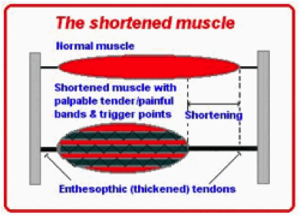What is Dry Needling?
Dry needling is an effective and efficient technique for the treatment of muscular pain and myofascial dysfunction. Dry needling or intramuscular stimulation is a technique developed by Dr. Chan Gunn and is extremely effective for relaxing overactive muscles, which contain trigger points.
In simple terms, the treatment involves needling of a muscle’s trigger points without injecting any substance. Dry needling is based on Western anatomical and neurophysiological principles. It should not to be confused with the Traditional Chinese Medicine (TCM) technique of acupuncture. However, since the same needles are used in both dry needling and acupuncture, the confusion is understandable.
What is a Trigger Point?
Myofascial trigger point is defined as a “hyperirritable spot in a skeletal muscle.” The spot is painful on compression and can give rise to characteristic referred pain, referred tenderness, motor dysfunction and autonomic phenomena.
 Myofascial trigger points are commonly seen in both acute and chronic pain conditions. Dry needling of the ‘shortened’ muscle band causes an immediate palpable relaxation. A sense of release and increased range of motion is often experienced by the patient.
Myofascial trigger points are commonly seen in both acute and chronic pain conditions. Dry needling of the ‘shortened’ muscle band causes an immediate palpable relaxation. A sense of release and increased range of motion is often experienced by the patient.
When used in conjunction with motor control retraining thru therapeutic exercises and postural and movement behavior retraining (Neuromuscular Re-Education), the release obtained from dry needling can be long lasting.
Dr. Rhonda Cowern received her dry needling education from Spinal Manipulation Institute – American Academy of Manipulative therapy under the instruction of Dr. James Dunning. Rhonda completed DN-1 Upper extremity 27 hours of direct contact in June 2015; and DN-2 Lower Extremity 27 hours of direct contact in November 2015 while also completing her 250 practice hours before the Utah State Licensing board approved her Trigger Point Dry Needling Certification. If you have any questions about dry needling please call our clinic at (435) 210-1985.
Why only 54 hours of direct hands on course work required?
Much of the basic anatomical, physiological, and biomechanical knowledge that dry needling uses is taught as part of the core physical therapist education during a three year doctorate of physical therapy program. As Physical Therapists, we’re deeply knowledgeable in the area of neuromusculoskeletal function. Whenever we apply a technique—dry needling or joint mobilization or whatever it is—we’re coming into it with a strong foundation in anatomy, physiology, and biomechanics, and we’re using our clinical reasoning skills to apply the sum of our knowledge to the optimal restoration of function based on that individual’s current injury
– APTA Resource Paper
Dr. Rhonda Cowern will evaluate your pain and dysfunction prior to deciding if dry needling is the right technique for you in combination with skilled physical therapy exercise, manual soft tissue mobilization, neuromuscular re-education, and functional retraining will be used in combination with dry needling interventions. Our patients will be educated in appropriate self-care techniques post-dry needling treatment, which may include specific strengthening or stretches of the involved muscles to improve your functional mobility.
If you would like to receive a White Paper that further explains Dry Needling please contact the clinic.